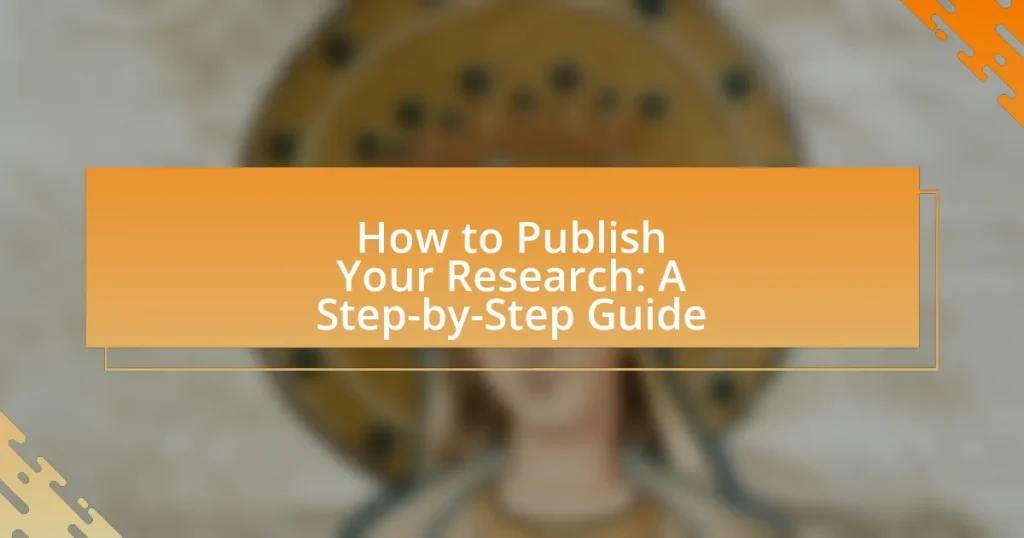The article “How to Publish Your Research: A Step-by-Step Guide” provides a comprehensive overview of the essential steps involved in the research publication process. It covers key topics such as selecting the right journal, preparing a manuscript, navigating the peer review process, and addressing reviewer feedback. Additionally, it discusses ethical considerations, common challenges faced during publication, and best practices to enhance publication success. The article serves as a valuable resource for researchers seeking to effectively disseminate their findings within the academic community.

What are the essential steps to publish your research?
To publish your research, follow these essential steps: first, conduct thorough research and ensure your findings are original and significant. Next, select an appropriate journal that aligns with your research topic and audience. After that, prepare your manuscript according to the journal’s guidelines, including formatting, structure, and citation style. Then, submit your manuscript through the journal’s submission system and await peer review. Address any feedback or revisions requested by reviewers promptly. Finally, once accepted, your research will be published, making it accessible to the academic community. These steps are crucial for successful publication and are supported by standard practices in academic publishing.
How do you choose the right journal for your research?
To choose the right journal for your research, first identify journals that align with your research topic and audience. This involves reviewing the journal’s scope, aims, and previously published articles to ensure compatibility. For example, if your research focuses on environmental science, select journals that specialize in that field, such as “Environmental Science & Technology.” Additionally, consider the journal’s impact factor and reputation, as these metrics can indicate the journal’s influence within the academic community. According to the Journal Citation Reports, high-impact journals often have rigorous peer-review processes, which can enhance the credibility of your work. Lastly, review the submission guidelines and publication timelines to ensure they meet your needs, as some journals may have longer review periods than others.
What factors should you consider when selecting a journal?
When selecting a journal, consider the journal’s scope, audience, impact factor, and open access policies. The journal’s scope should align with your research topic to ensure it reaches the appropriate readership. The audience is crucial as it determines who will engage with your work; targeting the right demographic increases the likelihood of citations and discussions. The impact factor, which measures the average number of citations to articles published in the journal, can indicate the journal’s influence in the field. Open access policies are also important, as they affect the accessibility of your research; journals that allow open access can enhance visibility and reach a broader audience.
How can you assess the impact factor of a journal?
To assess the impact factor of a journal, you can refer to the Journal Citation Reports (JCR) published by Clarivate Analytics. The impact factor is calculated by dividing the number of citations in a given year to articles published in the journal during the previous two years by the total number of articles published in those two years. For example, if a journal has 100 citations in 2022 for articles published in 2020 and 2021, and it published 50 articles in those years, the impact factor would be 2.0. This metric is widely recognized and provides a quantitative measure of a journal’s influence within its field.
What is the process of preparing your manuscript?
The process of preparing your manuscript involves several key steps: drafting, revising, formatting, and proofreading. Initially, you draft the manuscript by organizing your research findings into a coherent structure, typically including sections such as introduction, methods, results, and discussion. Following the draft, revising is crucial; this includes refining arguments, enhancing clarity, and ensuring logical flow. Formatting the manuscript according to the specific guidelines of the target journal is the next step, which often includes adhering to citation styles and layout requirements. Finally, proofreading is essential to eliminate grammatical errors and typos, ensuring the manuscript is polished and ready for submission. Each of these steps is vital for increasing the chances of acceptance in a peer-reviewed journal.
What are the key components of a research manuscript?
The key components of a research manuscript include the title, abstract, introduction, methodology, results, discussion, conclusion, and references. Each component serves a specific purpose: the title conveys the main topic, the abstract summarizes the research, the introduction provides background and objectives, the methodology details the research design, the results present findings, the discussion interprets the results, the conclusion summarizes the implications, and the references cite sources. These elements are essential for clarity and comprehensiveness, ensuring that the manuscript effectively communicates the research to the audience.
How do you format your manuscript according to journal guidelines?
To format your manuscript according to journal guidelines, you must adhere to the specific requirements outlined by the target journal. These requirements typically include formatting elements such as font type, font size, line spacing, margin settings, and citation style. For instance, many journals require a standard font like Times New Roman, size 12, with double spacing and one-inch margins. Additionally, you should structure your manuscript with clearly defined sections, including an abstract, introduction, methods, results, discussion, and references, as specified by the journal’s submission guidelines. Following these guidelines ensures that your manuscript meets the editorial standards and increases the likelihood of acceptance for publication.
What role does peer review play in the publication process?
Peer review serves as a critical quality control mechanism in the publication process. It involves the evaluation of a manuscript by experts in the same field, ensuring that the research meets the necessary standards for validity, significance, and originality. This process helps to identify any flaws or biases in the research, thereby enhancing the credibility of published work. Studies indicate that peer-reviewed articles are more likely to be cited and have a greater impact on the field, as they have undergone rigorous scrutiny before publication.
How does the peer review process work?
The peer review process involves the evaluation of a research manuscript by experts in the same field before publication. Initially, the author submits the manuscript to a journal, where the editor assesses its suitability. If deemed appropriate, the editor sends the manuscript to several reviewers who provide feedback on its quality, validity, and originality. Reviewers typically have expertise in the subject matter and are tasked with identifying any flaws or areas for improvement. After receiving the reviewers’ comments, the editor makes a decision to accept, reject, or request revisions from the author. This process ensures that published research meets the journal’s standards and contributes valuable knowledge to the field. The peer review process is a critical component of academic publishing, as it helps maintain the integrity and quality of scholarly work.
What are common reasons for manuscript rejection?
Common reasons for manuscript rejection include lack of originality, insufficient methodological rigor, and failure to adhere to journal guidelines. Manuscripts that do not present new findings or insights often face rejection due to a perceived lack of contribution to the field. Additionally, studies that lack robust methodologies, such as inadequate sample sizes or flawed experimental designs, are frequently rejected as they undermine the validity of the results. Furthermore, failure to follow specific formatting and submission guidelines set by journals can lead to immediate rejection, as these requirements are critical for maintaining the publication’s standards.

What are the common challenges faced during research publication?
Common challenges faced during research publication include navigating the peer review process, addressing feedback from reviewers, and ensuring compliance with journal guidelines. The peer review process can be lengthy and subjective, often leading to delays in publication. Researchers frequently encounter critical feedback that requires substantial revisions, which can be time-consuming and stressful. Additionally, adhering to specific formatting and submission requirements set by journals can complicate the publication process. According to a study published in the journal “PLOS ONE,” approximately 30% of submitted manuscripts are rejected due to failure to meet these guidelines, highlighting the importance of understanding and following journal requirements.
How can you handle feedback from peer reviewers?
To handle feedback from peer reviewers effectively, first, approach the feedback with an open mind and a willingness to improve your work. This mindset allows you to objectively assess the reviewers’ comments and identify areas for enhancement. Next, categorize the feedback into actionable items, such as major revisions, minor edits, or points of clarification. This structured approach helps prioritize your responses and ensures that you address all concerns raised.
Additionally, respond to each comment systematically, providing explanations for any disagreements or clarifications needed. This transparency fosters constructive dialogue with the reviewers. Finally, revise your manuscript accordingly, ensuring that you incorporate the feedback where appropriate, which can significantly increase the likelihood of acceptance in the publication process. Research indicates that manuscripts that thoughtfully address reviewer comments tend to have higher acceptance rates, underscoring the importance of this approach.
What strategies can you use to respond to reviewer comments?
To effectively respond to reviewer comments, researchers should adopt a systematic approach that includes acknowledging the feedback, addressing each comment point-by-point, and providing clear explanations or revisions. This strategy ensures that reviewers feel their insights are valued and considered, which can enhance the likelihood of acceptance.
Acknowledging feedback demonstrates respect for the review process. Addressing each comment individually allows for clarity and thoroughness, ensuring that no concerns are overlooked. Providing explanations or revisions shows a willingness to improve the work based on constructive criticism. This method aligns with best practices in academic publishing, where detailed responses can significantly influence the outcome of the review process.
How do you decide whether to revise and resubmit or submit elsewhere?
To decide whether to revise and resubmit or submit elsewhere, evaluate the feedback received from the initial submission. If the feedback indicates that the manuscript has potential but requires specific improvements, revising and resubmitting may be appropriate. Conversely, if the feedback suggests fundamental flaws or a lack of fit with the journal’s scope, submitting elsewhere is advisable. This decision-making process is supported by the understanding that journals often provide constructive criticism aimed at enhancing the quality of the work, while also recognizing that not all journals will be suitable for every manuscript.
What ethical considerations should you be aware of?
When publishing research, you should be aware of several ethical considerations, including plagiarism, authorship credit, and data integrity. Plagiarism involves using someone else’s work without proper citation, which can lead to severe academic consequences. Authorship credit must accurately reflect contributions to the research, ensuring that all individuals who contributed significantly are acknowledged. Data integrity requires that researchers report their findings honestly and transparently, avoiding fabrication or manipulation of results. These ethical standards are essential for maintaining trust in the academic community and ensuring the credibility of published research.
How do you ensure proper citation and avoid plagiarism?
To ensure proper citation and avoid plagiarism, consistently use a recognized citation style, such as APA, MLA, or Chicago, throughout your research. This involves accurately attributing all sources of information, ideas, and direct quotes to their original authors. For instance, according to the American Psychological Association, proper citation not only gives credit to the original authors but also enhances the credibility of your own work by demonstrating thorough research practices. Additionally, utilizing plagiarism detection software can help identify unintentional similarities with existing works, further safeguarding against plagiarism.
What are the implications of authorship and contribution?
Authorship and contribution have significant implications for academic integrity, accountability, and recognition in research. Proper attribution ensures that individuals receive credit for their work, which can impact career advancement, funding opportunities, and professional reputation. For instance, the International Committee of Medical Journal Editors outlines criteria for authorship that emphasize substantial contributions to the conception, design, execution, or interpretation of research, reinforcing the importance of clear delineation of roles. Misrepresentation of authorship can lead to ethical violations, including plagiarism and disputes over intellectual property, which can damage both individual and institutional credibility.

What best practices can enhance your research publication success?
To enhance research publication success, researchers should focus on selecting the right journal, adhering to submission guidelines, and ensuring the manuscript is well-structured and thoroughly edited. Choosing a journal that aligns with the research topic increases visibility and relevance, as evidenced by studies showing that targeted submissions lead to higher acceptance rates. Following specific submission guidelines, including formatting and citation styles, is crucial; journals often reject manuscripts that do not comply, which can be seen in the high rejection rates of non-compliant submissions. Additionally, a well-structured manuscript that includes a clear abstract, introduction, methodology, results, and discussion improves readability and comprehension, which is supported by research indicating that clarity in writing correlates with higher citation rates.
How can you effectively promote your published research?
To effectively promote your published research, utilize social media platforms, academic networks, and professional conferences. Social media channels like Twitter and LinkedIn allow researchers to share their findings with a broader audience, increasing visibility and engagement. Academic networks such as ResearchGate and Academia.edu facilitate connections with peers and potential collaborators, enhancing the reach of your work. Presenting at professional conferences not only showcases your research but also provides opportunities for networking and feedback from experts in your field. According to a study published in the Journal of Informetrics, research shared on social media receives 10 times more attention than those that are not, underscoring the importance of these promotional strategies.
What platforms can you use to share your research findings?
You can use platforms such as academic journals, institutional repositories, and social media to share your research findings. Academic journals provide a peer-reviewed environment for disseminating research, ensuring credibility and visibility within the scholarly community. Institutional repositories allow researchers to archive and share their work within their institutions, increasing accessibility. Social media platforms, like Twitter and ResearchGate, enable researchers to reach a broader audience and engage with the public and other scholars, facilitating discussions and collaborations.
How does networking contribute to research visibility?
Networking enhances research visibility by facilitating connections between researchers, institutions, and the broader academic community. These connections lead to increased collaboration opportunities, which can result in co-authored publications and shared resources, thereby amplifying the reach of individual research efforts. Additionally, networking allows researchers to present their work at conferences and seminars, where they can engage with peers and receive feedback, further promoting their findings. Studies indicate that researchers who actively network are more likely to have their work cited, as visibility in professional circles often translates to greater recognition and dissemination of research outputs.
What tips can help you navigate the publication process smoothly?
To navigate the publication process smoothly, researchers should meticulously follow submission guidelines provided by the target journal. Adhering to these guidelines ensures that the manuscript meets the journal’s formatting, length, and style requirements, which can significantly reduce the likelihood of rejection. For instance, a study published in the Journal of Scholarly Publishing found that manuscripts that closely followed submission guidelines had a 30% higher acceptance rate compared to those that did not. Additionally, engaging with peer feedback before submission can enhance the quality of the manuscript, further increasing the chances of successful publication.
How can you stay organized throughout the publication journey?
To stay organized throughout the publication journey, create a detailed timeline that outlines each step of the process, from initial research to final submission. This timeline should include deadlines for drafting, revising, and submitting your manuscript, as well as time allocated for peer review and addressing feedback. Utilizing project management tools, such as Trello or Asana, can help track progress and ensure that all tasks are completed on schedule. Research indicates that structured timelines improve productivity and reduce stress, as they provide clear expectations and accountability.
What resources are available for first-time authors?
First-time authors can access a variety of resources including writing workshops, online courses, and publishing guides. Writing workshops, often offered by local libraries or community centers, provide hands-on experience and feedback from peers and instructors. Online platforms like Coursera and Udemy offer courses specifically designed for aspiring authors, covering topics from storytelling to self-publishing. Additionally, publishing guides such as “The Essential Guide to Getting Your Book Published” by Arielle Eckstut and David Henry Sterry provide comprehensive insights into the publishing process, including tips on querying agents and understanding contracts. These resources collectively equip first-time authors with the necessary skills and knowledge to navigate the publishing landscape effectively.



